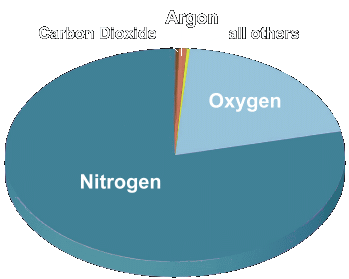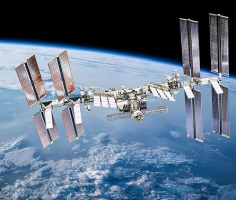
|

|
 The atmosphere is 78% Nitrogen, which enters the soil and participates in the growth of plants.
The atmosphere is 78% Nitrogen, which enters the soil and participates in the growth of plants.Oxygen makes up about 21% of the air we breathe, driving the metabolisms of most living things, which need oxygen to stay alive. Argon is 0.94% of the atmosphere. It's an inert gas, one which doesn’t interact with other substances, and has no biological role. Carbon Dioxide makes up 0.04% of our air. It's a greenhouse gas that plays a crucial role in regulating the planet's temperature. These percents can vary slightly, as water vapour is also present, and can represent as much as 4% of the atmosphere. Earth’s atmosphere has five major layers. From lowest to highest, the major layers are the Troposphere, Stratosphere and Mesosphere, representing over 99.99997% of the air above us, as well as the Thermosphere and Exosphere that range all the way to space. Troposphere  Earth’s troposphere extends from the surface to about 12 kilometres in height. This shallow layer holds all the air plants need for photosynthesis and animals need to breathe, and also contains about 99% of all water vapour suspended in the atmosphere. In the troposphere, temperatures drop as you go higher, since heat is generated by the transfer of energy from Earth’s surface.
Earth’s troposphere extends from the surface to about 12 kilometres in height. This shallow layer holds all the air plants need for photosynthesis and animals need to breathe, and also contains about 99% of all water vapour suspended in the atmosphere. In the troposphere, temperatures drop as you go higher, since heat is generated by the transfer of energy from Earth’s surface. The troposphere is the densest atmospheric layer, compressed by the weight of the rest of the air above it. Most of Earth’s weather happens here, and almost all clouds that are generated by weather are found in the troposphere, with the exception of cumulonimbus thunder clouds, whose tops can rise into the lowest parts of the stratosphere. Most aviation takes place here. Stratosphere  Located between approximately 12 and 50 kilometres above Earth’s surface, the stratosphere is perhaps best known as home to Earth’s ozone layer, which protects us from the Sun’s harmful ultraviolet radiation. Because of that UV radiation, the higher up you go into the stratosphere, the warmer temperatures become. The stratosphere is nearly cloud- and weather-free, but polar stratospheric clouds are sometimes present in its lowest, coldest altitudes. It’s also the highest part of the atmosphere that jet planes and weather balloons can reach.
Located between approximately 12 and 50 kilometres above Earth’s surface, the stratosphere is perhaps best known as home to Earth’s ozone layer, which protects us from the Sun’s harmful ultraviolet radiation. Because of that UV radiation, the higher up you go into the stratosphere, the warmer temperatures become. The stratosphere is nearly cloud- and weather-free, but polar stratospheric clouds are sometimes present in its lowest, coldest altitudes. It’s also the highest part of the atmosphere that jet planes and weather balloons can reach.
Mesosphere  Located between about 50 and 80 kilometres above Earth’s surface, the mesosphere gets progressively colder with altitude. The very scarce water vapour at the top of the mesosphere forms noctilucent clouds, the highest clouds in Earth’s atmosphere, which can be seen in summer under certain conditions and usually after sunset, as delicate, wispy blue or silver streaks across the sky.
Located between about 50 and 80 kilometres above Earth’s surface, the mesosphere gets progressively colder with altitude. The very scarce water vapour at the top of the mesosphere forms noctilucent clouds, the highest clouds in Earth’s atmosphere, which can be seen in summer under certain conditions and usually after sunset, as delicate, wispy blue or silver streaks across the sky.
Most meteors burn up in this atmospheric layer. Thermosphere  Located between about 80 and 700 kilometres above Earth’s surface is the thermosphere, whose lowest part contains the ionosphere.
Located between about 80 and 700 kilometres above Earth’s surface is the thermosphere, whose lowest part contains the ionosphere. In this layer, temperatures increase with altitude due to the very low density of molecules found here. This region is both cloud- and water vapour-free. The aurora borealis is sometimes seen here. The International Space Station and the Space Shuttle orbit in the thermosphere, as do Starlink satellites. Exosphere  Located between about 700 and 10,000 kilometres above the surface of the Earth, the exosphere is the highest layer of Earth’s atmosphere. Molecules found here are of extremely low density, so this layer doesn’t behave like a gas at all, and particles here escape into space.
Located between about 700 and 10,000 kilometres above the surface of the Earth, the exosphere is the highest layer of Earth’s atmosphere. Molecules found here are of extremely low density, so this layer doesn’t behave like a gas at all, and particles here escape into space. While there’s no weather in the exosphere, the aurora borealis is sometimes seen in its lowest part. Many Earth satellites orbit in the exosphere. 
The Edge of Outer Space While there’s really no clear boundary between where Earth’s atmosphere ends and outer space begins, most scientists use a height of 100 kilometres above Earth’s surface to mark the transition point, since 99.99997% of Earth’s atmosphere lies beneath this height. |